The V6 came in two basic configurations -- 2.8 liters and 2.6 liters.
Both engines share the same block and basic
configuration, but had different feature sets. I don't have much information
about the 2.6l engine, because it was not offered in the US and I don't have access to European
maintenance literature. If you have some factory service documentation on the 2.6l engine, please
let me know! I'm also on the lookout for power/torque graphs
for the AFC and ACK engines. Thanks as always for any information you can provide!
Common Features of the 2.8l and 2.6l engines:
- 90o angle V6
- Gray cast iron cylinder block
- Split-pin crankshaft with four main bearings
- Light alloy oil pan
- Two light alloy cylinder heads
- Valves operated by single overhead camshafts
- Self-adjusting hydraulic valve lifters
- Idle stabilizer with deceleration fuel cutoff
- Cross-flow cylinder heads
- Fully electronic fuel injection with cylinder-selective knock control
- Two three-way catalytic converters with oxygen sensors
- Self monitoring and diagnosis system
2.8L

- 2.8L / 169in3 / 2771cm3 displacement
- Maximum output: 174bhp DIN (128kW) @ 5500rpm
- Maximum torque: 250Nm (184ft. lbs.) @ 3000rpm
- Maximum engine speed: 6700rpm
- Bore: 3.25in / 82.5mm
- Stroke: 3.40in / 86.4mm
- Compression ratio: 10.3:1
- Accurate fuel metering by means of a heated-wire
air mass sensor
- Dual stage multi-path intake manifold
- Short intake path: 380mm
- Long intake path: 780mm
- Engine code: AAH, AFC, or ACK
- Weight: 355lbs / 161kg
- Length: 17in / 432mm
|
|
2.6L

- 2.6L / 158in3 / 2598cm3 displacement
- Maximum output: 150bhp DIN (110kW) @ 5750rpm
- Maximum torque: 225Nm (166ft. lbs.) @ 3500rpm
- Maximum engine speed: 6500rpm
- Bore: 3.25in / 82.5mm
- Stroke: 3.19in / 81.0mm
- Compression ratio: 10.0:1
- Engine code: ABC or ACZ
- Weight: ???lbs / ???kg
- Length: 17in / 432mm
I'm still trying to find some of this info!
I'd love
to hear it if you have it.
|
The AFC revision of the 2.8l V6 implemented many technical improvements over the initial AAH version. Some of the most
important changes are as follows:
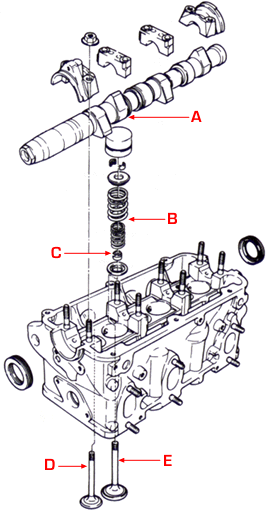 |
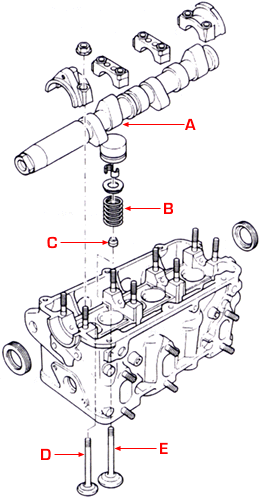 |
The AAH/AFC and AFC engines had a lighter valve train and different valve timing. Major differences
between the original AAH design (left) and the updated AFC design (right) include:
A: The AFC camshaft is lighter and provides different valve timing.
B: The valve spring assembly in the AFC engine has less mass and is a simpler design.
C: Valve stem oil seals are updated in the AFC engine to accomodate changed valve stem diameters.
D: AFC exhaust valves have a smaller stem diameter.
E: AFC intake valves have a smaller stem diameter.
|
The results from valve timing changes are as follows:
| Engine Code |
AAH |
AAH/AFC |
AFC |
| Dates |
11/1991 - 11/1994 |
8/1994 - 5/1995 |
12/1994 - |
| Torque |
184 ft-lbs = 250Nm |
184 ft-lbs = 250Nm |
180 ft-lbs = 250Nm |
| Compression Ratio |
10.3:1 |
10.3:1 |
10.0:1 |
| Intake valve opens |
4o |
10.5o |
10.5o |
| Intake valve closes |
42o |
45.45o |
45.45o |
| Exhaust valve opens |
42o |
37.5o |
37.5o |
| Exhaust valve closes |
2o |
2.55o |
2.55o |
| Min. RON (fuel octane) |
95 |
95 |
91 |
The AAH/AFC and AFC engines had an updated oil pan assembly as well. Some of the major
differences between the AAH (left) and AFC (right) engines include:
A: The updated engines use a larger oil filter.
B: The oil cooler in the AFC engine has a larger cross-sectional area.
C/D: The pressure relief valve is integrated into a cover assembly on the AFC engines.
E/F: The oil pickup is integrated into the upper oil pan on the AFC engines.
G: The lower oil pan gasket is revised in the AFC engine.
|
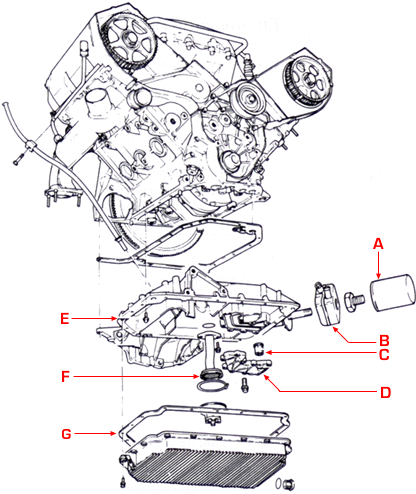 |
|
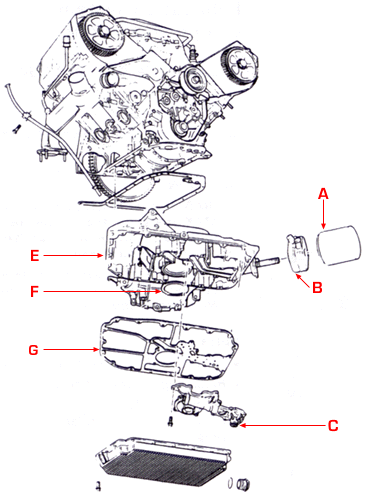 |
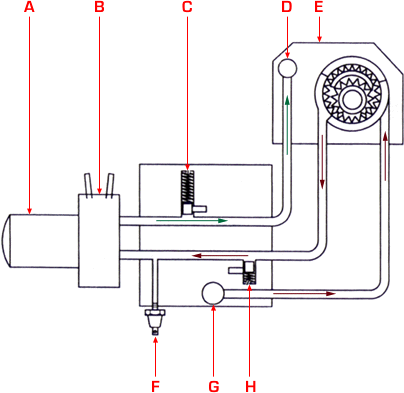
|
|
The AFC engines had a significantly different oil circulation system than the
AAH engines. The updated system works as follows:
Intake side:
Oil is drawn into the oil pump (E) through the oil pickup (G).
Pressure side:
Oil pressure comes from the oil pump past the upper part of the oil pan to the
11 bar (160 PSI) pressure relief valve (H), the oil pressure switch (F), the oil
cooler (B), and the oil filter (A) to the pressure relief valve (C) and finally
the engine (D).
The pressure relief valve (C) controls the oil pressure to the engine. The 11
bar (160 PSI) pressure relief valve (H) is a safety valve that opens only at
high RPM and cold engine temperature.
Advantages:
Oil pressure is controlled from the oil filter and oil cooler so that the oil
pressure available at those locations is supplied via the pressure relief valve (C)
or from the oil pump.
|
|
|







